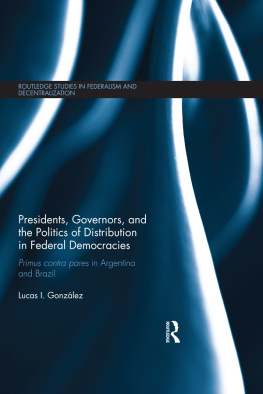The Governors and the New Federalism
The Governors and the New Federalism
Marshall Kaplan and Sue O'Brien
First published 1991 by Westview Press
Published 2019 by Routledge
52 Vanderbilt Avenue, New York, NY 10017
2 Park Square, Milton Park, Abingdon, Oxon OX14 4RN
Routledge is an imprint of the Taylor & Francis Group, an informa business
Copyright 1991 by Taylor & Francis
All rights reserved. No part of this book may be reprinted or reproduced or utilised in any form or by any electronic, mechanical, or other means, now known or hereafter invented, including photocopying and recording, or in any information storage or retrieval system, without permission in writing from the publishers.
Notice:
Product or corporate names may be trademarks or registered trademarks, and are used only for identification and explanation without intent to infringe.
A CIP catalog record for this book is available from the Library of Congress.
ISBN 13: 978-0-367-29261-4 (hbk)
During the height of the federal government's attack on American social problems in the 1960s and 1970s, scholars and practitioners frequently asked, "What about the states?" Doubts that the states could be counted on to make social policy seemed confirmed by reality. Governors and their aides were rarely asked to attend federal policy conferences in Washington. Very few states seemed to care about the tremendous growth in federal aid programs directed at poverty and social-welfare issues. Federal/city relationships supplanted federal/state linkages, constituting, in effect, a de facto constitutional amendment.
This situation was reversed in the 1980s, as the Reagan years brought about many significant and seemingly long-lasting changes in federalism, or the relationship between federal, state, and local governments. Clearly, states and local governments can no longer count on Washington for significant automatic budget increases for social-welfare initiatives. Just as clearly, they cannot look to the federal government for sustained leadership regarding new social-welfare policies and programs.
In many respects, the action shifted to the states in the 1980s. States have been pushed and, in some cases, have pushed themselves to the forefront of health, education, and welfare policy making. Their involvement was precipitated by the Reagan administration's budget cutbacks and efforts to cycle many federal aid programs through the states. State involvement was also precipitated by the economic and fiscal problems facing many local governments, particularly in the early part of the decade.
This book results from a Ford Foundation grant to the Graduate School of Public Affairs (GSPA) at the University of Colorado in Denver. It focuses on the leadership role played by eight governors in developing new or maintaining existing health, education, and welfare policies and programs. It purposely concentrates more on why and how governors acted than on the specifics of individual programs. It attempts to broadly classify different gubernatorial roles and their impacts on different kinds of policy development. Finally, to the extent possible, it relates the role of the governor to the political, economic, and institutional environment in each of the studied states.
We hope the book will provide governors, their staffs, and individuals interested in state government with insights into the relationship between varied modes of leadership and results. We also hope it will help present and future governors identify the decision-making processes that work best for them, their administration, and the citizens of their state. Finally, we hope the book will stimulate further research into the role of governors in setting policy and in developing programs.
The book is divided into three parts. compares the approaches of each of the studied governors and summarizes the findings on how economic, institutional, and political environments shaped the governors' responses to federal policy and program changes. It also provides brief observations on the effect of the governors' leadership on state bureaucracies and on state health, education, and welfare policies and programs.
We would like to thank the National Governors' Association and the Education Commission of the States for their help and support during this study. We are also grateful to Governors Lee Dreyfus, John Evans, William Janklow, Richard Lamm, Richard Snelling and William Winter for their willingness to participate in the oral-history colloquium that helped generate the data for this book. All these governors, plus Governors Michael Dukakis and Mark White, deserve our appreciation for agreeing to be the subjects of case studies. Dr. Robert Reischaur, Brookings; Dr. Ted Marmor, Yale; Dr. Frank Newman, Educational Commission of the States; and Dr. Ray Sheppach and Barry Van Lare of the National Governors' Association are to be thanked for interviewing the governors and joining the colloquium. We also want to acknowledge our colleagues at the University (Dr. Paul Bauman, Beth Lehr, Ken Torp, Carl Norbeck, State Senator Jack Fenlon) and NGA (Kelley Donley French) for their work on the case studies. Finally, but no less significantly, we want to extend our appreciation to Dr. Peggy Cuciti for describing the relationship between the states and the New Federalism, and to K.C. Mason for serving as our staff editor for the case studies.
Marshall Kaplan
Sue O'Brien
PART ONE
The States and the New Federalism
The Reagan Years and the States
'The action is back in the local area and that's where the solutions have to be found," said former U.S. Senator Lawton Chiles, the latest in a long line of federal officeholders seeking to move to the state or local level. In the words of David Broder, nationally syndicated columnist, the movement from Washington to the states "speak[s] volumes about where people of talent and integrity think they can make their best contribution these days. Hint: If s not in Washington."
Some observers would go further, arguing that the real change is in the role of state governments. As noted by Richard Nathan, there has been "a fundamental shift in the balance of power and responsibility in American federalism... the enhancement of the role of state governments vis--vis both the national and local governments."
The increasing importance of the states is attributed in large part to changes in federal policy initiated by President Ronald Reagan. He came into office committed to a new view of intergovernmental relationships. In his first inaugural, he spoke of his intention to "curb the size and influence of the federal establishment and to demand recognition of the distinction between the powers granted to the federal government [and] those reserved to the states or to the people." As part of President Reagan's New Federalism initiative, major changes in the structure of the grant system were proposed and enacted. Even more ambitious later efforts to reallocate responsibilities, however, failed.
President Reagan's New Federalism
To understand the shift in the balance of power in the federal system, one must look at fiscal policy and regulatory program changes as well as the programmatic shifts put forward as part of the president's New Federalism initiative.
Fiscal Policy
The pre-eminent concern of the Reagan administration was to reduce the role of government in the domestic sector. Governmental programs and the magnitude of taxes needed to support those programs were seen as important contributors to the economic problems that had beset the nation throughout the 1970s. To increase productivity, additional investment was required. To stimulate this investment and the savings required to support it, the administration recommended substantial cuts in marginal income tax rates.













